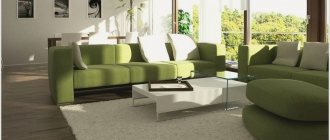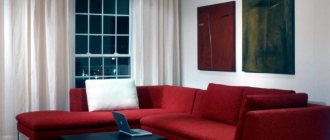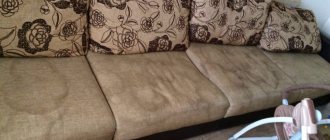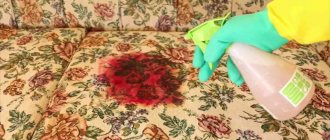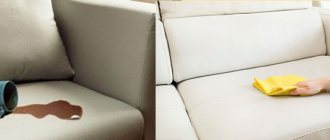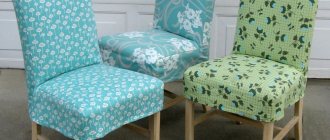Dry cleaning of furniture made from delicate fabrics
The first question that dry cleaning professionals ask their clients is: “What kind of upholstery material is the furniture?” They all differ in their raw material composition, density, formation structure and abrasion resistance.
The choice of technology, solvent, stain remover, amplifier supplied to the dry cleaning machine, and drying method depends on the type of upholstery. Therefore, identifying the upholstery material, source and intensity of contamination is very important. These parameters affect the quality of cleansing.
Dry cleaning workers, who have in their arsenal the best samples of cleaning chemicals, special equipment and devices, and previously tested the latest developments in the field of professional cleaning, are able to work with any fabrics, even delicate and unique ones with very long pile. One of such companies is dry cleaning of upholstered furniture Malina.
According to their performance characteristics, upholstery fabrics are divided into 3 types:
- delicate;
- daily use;
- intensive use.
Their main difference is that delicate fabric is more susceptible to fiber damage than others. If handled carelessly or incorrectly, it can stretch, shrink, and even tear.
It is important
The “delicate” category includes furniture fabrics that include silk, viscose threads, satin weave, and fine wool. Furniture, the parts of which are covered with such fabric, requires an individual approach. The rules for their processing are strictly regulated. It is prohibited to use substances that have an aggressive effect.
The dry cleaning process uses injection and steam extraction equipment. If necessary, resort to a combination of different cleaning methods.
Furniture made of pile fabrics – suede, velor, corduroy, velvet, plush – also needs special care. Furniture belonging to types 2 and 3 is practical, less “capricious”, and does not require particularly careful care. It is usually cleaned with a vacuum cleaner, brush, or damp sponge. But this is not the best way to deal with stains, odors, dust and microorganisms.
On a note
Self-removal of stains and odors using improvised means and low-quality chemicals can lead to dirt getting deep inside the fibers, and chemicals that have a pungent odor and the ability to provoke an allergic reaction in the inhabitants of the apartment will remain on the surface of the furniture (the greatest harm is caused to children, elderly people and pets).
As a result, the owners will receive a spotted sofa or chair with streaks and stains that will be impossible to remove in the future. If furniture and health are important to the owners, then cleaning should be entrusted to professionals. The conditions for long-term operation of furniture products are timely and correct actions to eliminate dirt, grease and house dust.
Dry cleaning of leather upholstered furniture with wax-containing compounds is a violation of standards
Many companies in their dry cleaning of leather furniture use formulations that contain wax, passing off the use of such products as services of the highest quality. In fact, the use of these compounds (wax with detergent components) when cleaning leather furniture is prohibited by dry cleaning rules. Negative changes after using such compositions are as follows:
- Skin pores become clogged with wax. Which leads to premature aging of the skin, as it stops “breathing”.
- After cleaning, the wax, remaining on the surface of the skin, begins to absorb dirt, clogging the pores of the skin with dirt.
- Wax gives the leather of upholstered furniture an uncharacteristic shine.
- After cleaning with wax-containing compounds, subsequent dry cleaning of leather furniture will be very difficult, since it will be technologically difficult to remove the wax, along with the dirt that has been absorbed into it from the pores of the leather.
Violations involving the use of compounds containing wax when cleaning leather furniture are allowed by cleaning companies and mobile dry cleaners. In this case, there is a lack of qualifications and necessary professional knowledge. Real professional cleaning products for upholstered leather furniture never contain wax.
How can a client understand that upholstered leather furniture is treated with wax compounds? If the leather of upholstered furniture becomes glossy, shiny, etc., instead of a matte shade, then the leather has been treated with wax.
Features of technology by materials
Upholstered furniture is a decorative and functional element of the interior, without which it is impossible to imagine a comfortable stay. Upholstery is an important detail. It allows you to change the appearance of a piece of furniture and improve its properties. The main purpose of upholstery is to cover the internal elements of furniture and protect them from damage.
It is also of great importance that the upholstery material is in direct contact with the human body. This determines the requirements for cladding. It is mainly represented by:
- upholstery textiles - velor, jacquard fabric, velvet (flock), silk, tapestry, matting and printed cotton;
- non-woven materials – leather, suede (natural or artificial);
- microfiber - there are woven and non-woven fabrics.
Each owner chooses cladding based on the purpose of use and the type of room for which the furniture product is intended. When choosing, he is guided by his own preferences and capabilities.
Thus, for apartments where families with children live, they most often choose eco-friendly, hygienic and breathable natural fabrics that can pleasantly warm in winter and cool in the warm season. The most popular materials are velor, velvet, cotton, viscose.
Suede, velor, leather, and silk are more suitable for offices and living rooms. They look stylish and respectable. Unlike non-natural fabrics (flock, jacquard, chenille), these materials are less resistant to external influences, easily absorb dirt and odors, in most cases do not tolerate cleaning with water and standard household products, do not like heat treatment, can become deformed and shrink .
Consider
Furniture made from such fabrics requires special care, because... there is a significant risk of harm. These are situations when, after cleaning on your own, the fibers become hard and unsightly in appearance, streaks appear on the surface, local dye loss, areas with a discolored color, and the upholstered furniture product looks “exhausted.”
Given such factors, dry cleaning is simply necessary. Only professionals will be able to preserve your favorite furniture and extend its service life by choosing the most suitable technology, detergent and appropriate tool for the capricious fabric. High-quality cleaning involves a multi-step process.
At the initial stage it is mandatory:
- the type of fiber and dye, the structure of the upholstery fabric are diagnosed, and if stains are present, the source of contamination and “age”;
- information is collected about the manipulations carried out with furniture - previous dry cleaning or independent attempts;
- The effect of the selected type of chemical is tested on a small (inconspicuous) area of the furniture surface.
Having determined the scope of work, selected the necessary methodology and certified gentle cleaning agents, dry cleaning employees begin to remove the problem. Only with this approach can you get a guaranteed result. When cleaning furniture, special attention is paid to components and built-in elements (sofa cushions, armrests), cracks, joints, and other hard-to-reach places. Dirt is removed from the outer surface of the furniture and from the inside of the material. Modern equipment allows you to penetrate deep layers, removing dust and odors even from fillers.
Dry cleaning a silk sofa
Each upholstery material has its own characteristics, and it is important to take them into account. Silk fabrics are made from the finest threads of uniform thickness. When forming the fabric, natural, synthetic fibers and mixed compositions can be used.
Fibers, in turn, are divided into groups: cellulose - acetate and viscose; chemical fibers – polyester, polyamide, polyacrylic. The composition determines the mechanical properties of silk upholstery, external characteristics, degree of shrinkage and resistance to reagents.
It is almost impossible to find a sofa cover made of 100% silk. This is explained by the fragility of the material and its extreme impracticality. The fabric easily absorbs moisture, even a small drop, spreading, forms a clearly visible stain of a large area. The disadvantages of silk upholstery include:
- low strength of the fabric, high probability of ruptures and abrasion;
- poor color fastness;
- tendency to form streaks that do not disappear after drying;
- possible separation of threads, deformation, changes in structure, pattern, appearance of puffs.
The introduction of synthetic fibers allows the introduction of synthetic fibers to give natural silk new qualities and improve its performance characteristics. The exact composition is indicated in the labeling (on the label). Fabrics consisting of different types of fibers, having a small admixture of synthetics, also tend to get dirty, fray, and quickly become unusable.
Removing stains on silk without dry cleaning is problematic. This is one of the most capricious matters. Cleaning silk furniture is difficult even for professionals. To ensure that silk sofa upholstery remains light, smooth, and shiny after processing, it is important to adhere to certain requirements and rules:
- Dry (waterless) cleaning technology should be used in an environment of organic solvents, which excludes the possibility of using a steam generator, a washing vacuum cleaner, soap solutions, and water-based foam cleaners;
- silk with a fleecy surface is strictly prohibited from being processed wet. It is permissible to use a liquid detergent composition only in the case of smooth silk (if the work is performed by a professional!);
- the cladding surface is sensitive to alkali and acid - the chemicals used must have a neutral pH;
- Mechanical impact should be minimized, the sofa should be dried at a low temperature, and the processing time should be reduced;
- Frequent dry cleaning of silk sofas is contraindicated.
Dry cleaning a velor sofa
The name itself (in translation the word means “shaggy”) suggests that we will be talking about a material that has a soft pile front surface. This is a type of velvet, but has a longer pile. It is often called suede, which is fundamentally wrong, because... suede is devoid of a facial layer - both sides are velvety.
In the manufacture of sofas, different types of velor are used in the design of the pile - smooth, shaped, printed (embossed), sanded. The fabrics may contain natural threads - cotton, wool, and chemical fibers, and have an additional coating - Teflon or “anti-claw”. Materials containing natural fibers and synthetic velor require different reagents.
Pile threads and the presence of special impregnation determine the consumer properties, appearance and physical indicators of the sofa upholstery - deformation, strength, thermal, density indicators. In most cases, velor coating is characterized by relatively low strength, a tendency to quickly get dirty, wear out with the formation of bald spots, absorb liquid and odors, and lose shape and volume. Over time, the pile begins to crush and become saturated with dust. Velor dye is unstable. To restore a velor sofa to its beautiful appearance, avoid damage and the need to reupholster the cover, it is recommended to order dry cleaning.
Mandatory conditions for quality cleaning:
- gentle mechanical action;
- the use of pre-tested high-quality stain removers and solvents, a ban on the use of powder formulations;
- deep penetration - the use of extractor machines capable of penetrating into the pile;
- cleaning along the direction of the pile;
- cleaning in several modes: vacuum, which involves removing coarse dirt, uniformly applying a cleaner under high pressure to knock out dirt; treating the sofa with a jet of chemicals; suction of debris and dust; manual removal of stubborn stains; pressure washing;
- additional treatment with disinfectants and antistatic agents;
- Thorough drying of the sofa by blowing or by extracting moisture with a special apparatus.
Only professional dry cleaning can clean furniture made from velor. The company’s employees will help you get rid of even old “traces.” How to clean it yourself: vacuum the sofa only using special attachments, comb it with a brush with dense soft bristles.
Removing stains on your own is fraught with troubles: destruction or creases in the pile, bald spots, stubborn stains, dye migration, discoloration, and unsightly halos.
Dry cleaning a velvet sofa
Most people associate velvet with luxury, sophistication, and prosperity. Velvet is used quite often for interior decoration. It belongs to the category of pile fabrics for which professional cleaning is recommended. Velvet is a dense natural or artificial material with thick short pile (only on the front side).
Traditionally, it is based on silk threads, but in order to save money they are often replaced with cotton or wool. This is a very delicate material. In terms of strength and density, velvet is inferior to velor, therefore it is forbidden to rub it, subject it to intense mechanical stress, or treat it with potent reagents. The rules for processing a sofa made of velvet and velor are largely similar.
If the drapery is made of synthetic velvet, then such a sofa is quite easy to clean, but it also attracts a lot of small litter and dust, because... has the property of becoming electrified. Such “dusty” immediately catches the eye. Upholstery made of natural velvet strongly absorbs moisture, takes a long time to dry, and is prone to the formation of halos and tannin stains (light yellow marks). This complicates the cleansing process.
Remember!
Dry cleaning furniture with velvet upholstery is a unique procedure; there are no standard algorithms for removing contaminants. The nature of the fibrous composition, color, workmanship, degree of soiling of the sofa, and complexity of the stains are taken into account. Achieving the required quality is the task of the technologist.
Velvet samples undergo preliminary testing. To clean, they often resort to manual processing. The environment, cleaning chemicals, brushes, and operating mode of washing equipment are selected individually.
Dry cleaning of Alcantara sofa
Alcantara is an innovative finishing material known as faux suede. It is soft, velvety, elastic, pleasant to the touch. Compared to delicate fabrics, Alcantara does not wear out, does not become shiny, and does not deform under mechanical stress. Due to its beauty, practicality, and functionality, it is widely used for upholstery of furniture products.
Alcantara upholstery
For cleaning, any processing method can be used: dry cleaning, wet cleaning, incl. soap solution, wet wipes without alcohol. The products used must not contain bleaching components.
Simple leather cleaners are suitable for cleaning an Alcantara sofa. The services of a dry cleaner will be required when there are old stains on the surface or a high degree of contamination. When cleaning using an artisanal method, there is a risk of loss of color uniformity. The specialist will carry out deep cleaning and will not harm the surface of the sofa.
Dry cleaning of a sofa made of natural suede and nubuck
A separate category is represented by materials produced from animal skins. Suede and nubuck are actively used to cover sofas. They are similar in appearance and have similar qualities. The main difference is the type of raw material (leather), the method of dressing and surface treatment. This determines the presence of some distinctive features: suede has a higher pile, softness, porous structure, less sensitivity to moisture, alkali, and friction.
Nubuck is thicker and stronger, but it is more afraid of dirt and water, it becomes greasy faster, and you cannot use an aqueous solution to wash it - only dry cleaning is used. Both materials require complex care, special processing conditions, and the use of special products to preserve the volume of the pile and the color of the sofa.
Basic Rules:
- selection of a cleaner depending on the method of leather production, the type of stains on the upholstery, the degree of soiling of the sofa;
- the use of a powerful extractor that allows you to heat the reagent solution, transport it deep into the fleecy material, and effectively remove the contaminant;
- complex application, uniform distribution of chemicals over the entire surface of the sofa;
- eliminating excessive friction and aggressive cleaning media;
- complete removal of waste chemicals;
- additional disinfection from harmful bacteria, dust mites, and other microorganisms.
Simple rules for safe cleaning
Before you start cleaning the sofa yourself using any improvised or chemical means, you need to carefully study all the nuances. Consider the degree of contamination, the material of your furniture and the characteristics of the cleaning products. To carry out the procedure correctly and not spoil the appearance of the furniture, follow the following rules:
- ⭐ Before starting a total cleaning, conduct an experiment: apply the product you choose to a small, inconspicuous part of the furniture. Be sure to wait for the final result. Only after successfully cleaning a small area should you begin to treat the entire sofa.
- ⭐ When using a vacuum cleaner, use only attachments designed for furniture.
- ⭐ Do not use several chemicals at the same time. You can't predict how they will react to each other. The result of such cleaning can be completely destroyed upholstery.
- ⭐ When trying to scrub large stains, start from the edge and move towards the middle of the stain. This should be done in order not to spread the dirt even more extensively.
- ⭐ After cleaning, thoroughly dry the furniture. Use ventilation, open windows or heating in winter. Furniture that is not dried dry may then acquire an unpleasant damp smell.
- ⭐ Do not use chlorine-containing products, they may change the color of the upholstery of the area being cleaned.
- ⭐ Be careful when working with furniture that has wooden, plastic or metal parts. They can be wiped with a slightly damp soft cloth. Any chemical solutions can permanently damage metal or plastic elements. Wooden parts can also be damaged by excessive moisture.
- ⭐ If you used any products other than water, carefully remove any remains. If you do not completely clean your sofa of them, they can cause allergic reactions.
DIY dry cleaning
Dry cleaning is carried out when the furniture becomes dusty and loses its former luster. The procedure can be carried out in two effective ways:
- Vacuum with a special attachment. You should go through the vacuum cleaner everywhere: the main surface, the back, the armrests. In this case, you can put gauze on the vacuum cleaner nozzle, after moistening it in water. As soon as the gauze becomes dirty, it needs to be changed.
- Knock out accumulated dust. However, you can’t just take a plastic beater and use all your strength to beat your sofa. This may damage or tear the upholstery material. In order to avoid such a development of events, take an old light-colored fabric. Moisten it with water or vinegar solution (1 tablespoon per 1 liter of cold water), squeeze well and completely cover the soft parts of the furniture. After this, you can start tapping with light pats. Dirt and dust will settle and linger on the damp sheet. When it gets dirty, rinse it and continue the procedure.
If the work carried out using a vacuum cleaner or knocking out did not give the desired result, do not despair.
You can use special powders that are not diluted in water - they can also be used for dry cleaning.
Here's a quick guide:
- The powder must be scattered evenly over the entire surface of the sofa.
- Wait for the time stated in the instructions for use.
- Remove the powder with a vacuum cleaner.
Wet cleaning of sofas
When the material of your sofa allows for wet cleaning, it makes the task easier.
Most housewives choose laundry soap dissolved in water. This type of cleaning works well if there are no old stains. .
For cleaning to be effective, you must:
- Make a solution of soap and water.
- Clean using napkins. Scrub your sofa upholstery in stripes, not circles. When using circular movements, streaks may appear.
- Wash the sofa with a cloth soaked in water without soap.
- Wipe the upholstery dry or dry the sofa with a fan.
If there is no effect, you can resort to using store-bought products: there are special gels and shampoos for cleaning upholstered furniture. They work on the same principle and always have detailed instructions for use.
Chemical cleaning products
When furniture has not been cleaned for a long time or is heavily soiled due to its material, you need to use chemical cleaning agents. Choose the product carefully, as it is very easy to damage the upholstery if chemicals are used. Chemicals can be used for both dry (gels and powders) and wet cleaning (shampoos, foams). They have detailed instructions on the packaging that must be followed completely.
Dry cleaning of upholstered furniture at the client's home
Modern technologies and compact equipment make it possible to provide customers with... This is a fairly popular area of activity. Qualified specialists carry out diagnostics and cleaning right on the spot - in an apartment, office, cafe, hotel, etc. To clean and update soft interior items in the shortest possible time and not damage the upholstery, dry cleaning workers perform a number of operations:
- Inspection of products, identification of upholstery material, dye. Identification and recognition of stains and areas requiring special treatment. Determination of places most susceptible to sweat and fat pollution. Warning owners about possible consequences.
- Choosing the optimal pre-wash stain remover and solvent for a specific upholstery - effective, harmless to health, environmentally friendly, and not damaging to the product.
- Applying cleaning agents to a contaminated surface in order to destroy dirt compounds.
- Preliminary cleaning with the help of special devices of the most contaminated areas and stains that can become permanently fixed during the general cleaning process with the impossibility of their further removal.
- Carrying out general dry cleaning (usually using the extractor method).
- Flushing. If necessary, treatment is carried out with an antistatic agent, a deodorizing composition, and a special shampoo that helps renew the color.
- Professional drying of treated furniture, allowing you to remove up to 90% of moisture.
- For some products, other finishing operations are additionally included - impregnation with a hydrophobic agent, tinting.
- Repeated cleaning in cases where the stain has not disappeared.
When having specialists visit your home, you should keep in mind that the more complex the stains, the longer it will take to clean and the higher the cost. The disadvantages also include possible discomfort from a working extractor or from the presence of a stranger. You should pay attention to what reagents will be used - the chemicals must be safe for people present in the room (do not contain toxic substances).
The advantages of this dry cleaning option are as follows:
- decent quality of cleaning without the need to deliver rather large furniture items to the workshop;
- eliminating the risk of damage to furniture during transportation;
- the opportunity to receive a clean, pleasant-smelling sofa on the same day of application - you can sit on a sofa or chair dried using professional equipment in just a few hours;
- saving time, controlling the process;
- providing a guarantee, detailed recommendations for further care and proper use.
Wet dry cleaning of upholstered furniture
One of the ways to clean soft modules is professional wet (wet) cleaning, otherwise known as aqua-cleaning. The name of the technology indicates that the solvent is warm, clean water. The method involves injecting a detergent composition into the thickness of the surface being treated and subsequent collection of its residues and dirt particles. Thanks to the suction power used in the technique, the sofa quickly becomes dry.
In terms of efficiency, this technology is a full-fledged alternative to chemical cleaning, but the natural component as a solvent has undoubted advantages over chemistry:
- non-toxic, does not cause allergies;
- provides the most gentle care and natural cleanliness;
- suitable for most types of stains, even old dried ones;
- does not leave streaks or an unpleasant pungent odor - the cleaner is easily and completely washed out.
The method is considered the most optimal option when cleaning and caring for furniture with moderately or heavily soiled surfaces.
The main criteria for the effectiveness of the technology:
- pile and fabric fibers tolerate water well;
- the existing contaminant is soluble in water;
- no artisanal grouting of the upholstery was carried out.
Dry cleaning of sofas and armchairs
The dry cleaning method involves the use of a solvent based on a chemical compound. The most powerful is perchlorethylene, but it poses a carcinogenic hazard and has an aggressive effect. For delicate fabrics, the tanks of dry cleaning machines are most often filled with a hydrocarbon solvent, the disadvantage of which is its low cleaning power. Therefore, the method is acceptable for minor and superficial contamination.
It includes 2 ways:
- powder cleaning - when the cleaning composition includes small substances that, like a sponge, absorb and bind dirt;
- foam cleaning - using a steam generator, a special foam with a low moisture content is formed on the surface of the sofa being cleaned, binding dust and debris.
Advantages of dry cleaning technology:
- minimal moisture, which is necessary for fabrics sensitive to water;
- does not allow upholstery to shrink, streaks to appear, or discoloration;
- no need for prolonged drying.
Features of cleaning a sofa at home
However, dry cleaning a sofa at home is carried out using different technologies and technological maps, and you need to specify the method and methods of cleaning in advance, namely:
Not all companies and craftsmen clean the sofa from all sides, outside and inside. Comprehensive cleaning of a sofa involves not only cleaning the cushions and seat, but also debris in the cracks, between the back and seats, wet cleaning of laundry drawers and even the frame of the sofa and its legs.
The sofa cleaning you order should include removing stains and neutralizing odors. To avoid price gouging, the presence of difficult stains must be discussed in advance.
Dry cleaning of furniture covers at the factory
Those who do not like monotony and prefer frequent changes in the interior often purchase removable covers. They are easy to change and caring for furniture with such removable parts is much easier. An effective replacement for regular washing, which is completely unacceptable in the case of delicate or expensive fabrics, is professional cleaning in an industrial workshop. Companies providing the service, at the request of the client, provide delivery to the place and arrive at the exact agreed time.
The technological cleaning process at the factory is strictly regulated and includes several stages:
- Reception and inspection of furniture covers.
- Choosing the most correct cleaning method depending on the specifics of the upholstery material, the presence of a gasket (soft flooring layer), defects, degree and type of contamination. Determination of the type and dosage of detergents.
- Preliminary cleaning of specific stains and heavily soiled areas using stain removal machines, tables equipped with guns, brushes, and an extractor.
- Washing: the technologist can assign a gentle wash in a water cleaning machine with a microprocessor control panel that automatically controls all parameters and stages of work - the method of solvent addition and quantity, injection temperature, duration of supply of the detergent, speed and rhythm of drum rotation. If conditions permit, the furniture cover can be cleaned by placing it in a dry cleaning machine equipped with an adsorber. This is a kind of absorber that ensures complete removal of the solvent from the cleaned cover.
- Drying that guarantees gentle moisture extraction.
- Finishing operations performed on industrial equipment - ironing, tinting, restoration of coatings, etc.
- Packing of cases and return to the owner.
Removing stains from delicate fabric furniture
If there is a stain on furniture upholstery made of delicate fabric, then it is the responsibility of the technologist to determine in what environment it is removed. To make the task easier, experts divided the most common spots into groups. The criterion for separation was the origin of the contamination; each has its own stain remover. Fabric with stains of unknown origin must be tested first. For delicate fabrics, the risk of damage cannot be completely ruled out.
| Stain classification | Types of stains | Peculiarities | What to delete |
| Food | Tannic: tea, cocoa, natural wines, berries, fruits, coffee, beer | Requires quick removal from the fabric so that they do not turn into difficult-to-remove stains | Acidic preparations |
| Sugar: fruit, vegetable juices, sauces, sugar | At high temperatures they produce caramelization. Tomato juice leaves especially difficult stains. Pre-treatment required | Alkaline stain removers, water-based. Fixed stains often cannot be removed | |
| Fatty: animal fat, vegetable oils, foods containing fatty acids - saturated and unsaturated | Insoluble in water. Fresh spots are dark, old ones lighten. May require amplifier | Washing in organic solvents (volatile) | |
| Protein compounds: egg whites, leftovers, milk | When fresh, they are soluble in water. Cannot tolerate high temperatures or acid exposure | Alkaline environment, enzymatic cleaners | |
| Household | Resins, oil paints, varnishes, inks, rust (oxides), adhesives | Stripping is required to separate the paint particles and avoid pigment dirt from fixing on the upholstery. If the fabric allows, use a steam gun (keep at a distance, avoiding exposure to excessively hot steam), bleaching dye residues | Organic solvent. For rust - a strong acid stain remover (if the color and fragility of the fibers allows), for ink - alkaline |
| Medicinal | Zelenka, iodine, lapis pencil, other brightly colored medicines | Mechanical impact with a brush or spatula is prohibited. | Neutral remedy |
| Cosmetic | Perfumes, foundations, creams, lipsticks, shadow marks, hair care products | The boundaries are clearly visible. Stains become hard over time and will require cleaning to soften them. | Solvent, water treatment without high temperatures |
| Products of exchange | Blood, streaks on the folds of sleeves or on the collar from contact with the body, urine, sweat, other bodily fluids | Over time they become hard and can be felt to the touch. Sweat can disturb the coloring. If the fabric has turned yellow, resort to optical brighteners or bleaches (if a successful result is obtained during testing) | Combined complex of surfactants and enzymes |
Removing stains at home
Even the most difficult and stubborn stains can be removed at home. This does not require expensive detergents. The main thing is to choose the right method for removing stains, suitable for a particular upholstery, and follow all recommendations.
- Blood - this type of contamination is considered the most difficult. The stain that appears cannot be rubbed; it only needs to be blotted. Place a cloth soaked in cold water on the stain, then blot completely with a dry cloth. If the stain cannot be removed with ordinary water, then you need to make a salt solution - 2 teaspoons per 1 glass of water. Old blood stains can be removed with hydrogen peroxide or ammonia. But the latter remedy should be used carefully, because it can damage the upholstery. If such serious contamination needs to be removed, the user is advised to contact a professional.
- Grease, cream - such stains can be covered with salt, talcum powder or chalk. The procedure is repeated several times.
- Juices, fruits - in this case, a mixture of vinegar and ammonia, diluted in proportions 1:1, helps.
- Coffee and tea can be easily removed with a regular soap solution.
- Ballpoint pen - rubbing such dirt is prohibited. You need to blot the area of contamination with alcohol.
- Urine - a solution of vinegar and soda will help remove the stain and eliminate the unpleasant odor.
- Jam, chocolate - you should wait until the stain dries so as not to rub it on the surface. Then the resulting crust is removed, and the mark is cleaned with a soap solution.
Removing odors from expensive fabric furniture
If a stain on the upholstery can be wiped away using improvised means, driving the dirt into the deep layers, then removing the unpleasant odor is not at all easy. Professionals additionally solve the problem of removing foreign odors that stubbornly do not disappear when trying to fix the problem on their own. The success of the event largely depends on the origin of the “aroma” and how long it bothers the owner of the furniture. Some odors are particularly persistent and cannot be completely removed the first time.
The process becomes more complicated if the furniture is made of expensive, delicate fabric. The tactics and product of influence are selected by the technologist in each specific case. In situations where the stench remains, the new effective technology “dry fog” will help. It helps eliminate any odors.
On a note
The cleaning principle is to ensure deep penetration of the reagent into all cracks, cavities and pores by turning it into a fine mixture similar to smoke.
Removing pet urine odor
The appearance of the smell of urine indicates poor quality of stain removal. Stains from animal urine are quite persistent and difficult to remove contamination. In addition to urea and urochrome (these are the components of urine - sticky and colored), which at first glance are “washed off,” urine contains thiols and other substances with a strong repulsive odor.
Dried uric acid and lingering urea cause the odor to return when moisture enters the area. Even after thorough rubbing, nitrogenous compounds remain in the fabric structure, giving off an odor. It will disappear only when all the constituent components of urine are neutralized. Professional approach:
- vacuum cleaning – the surface is cleaned of animal hair, wool, sand, dust;
- removal of red stains with chemicals - foam shampooing is carried out using a rotary machine;
- contaminated foam is collected;
- stubborn stains are removed;
- The upholstery is dried with a special hairdryer.
Removing the smell of vomit
In this case, the smell of furniture is given by the decay products of organic matter. It is important to immediately remove visible dirt and prevent the sofa from becoming saturated with caustic liquid. Using warm water will help the protein coagulate, causing the stain to become hard and form a permanent film. Household chemicals can harm expensive fabric, so a dry cleaner should select a neutralizing agent and carry out the cleaning. T
The technology for removing the consequences of contamination by vomit implies preliminary cleaning strictly before the main treatment. An alkaline or enzymatic stain remover must be used.
Removing odors and traces of fire
Upholstery that has a burning odor or has traces of fire must be cleaned in accordance with basic requirements. Deep dry cleaning or cleaning in an aqueous environment is carried out. After cleaning, the fabric is treated with ozone, a natural oxidizing agent that does not mask the burning smell, but rather removes it.
Tobacco odor removal
Steady cigarette smoke is an unpleasant phenomenon. To get rid of the consequences of smoking indoors, sometimes it is enough to carry out high-quality classic dry cleaning.
100% results are obtained only by ozone treatment and the use of an odor absorber operating at the molecular level. This service is provided by a cleaning company.
Removing musty smell
A musty, putrid smell is often the result of infrequent ventilation combined with high humidity. Such conditions lead to the proliferation of microorganisms that tend to penetrate deep into the sofa covering.
There is no point in masking the musty smell. To get rid of the “spirit of decay”, complete removal of microorganisms from the surface of the furniture and from the inner layers is required. In the fight against microbes, ozonation technologies have proven themselves to be the best.
Removing mold odor
Due to improper care - frequent flooding, lack of proper drying, the smell of dampness and mold may form on the furniture. It is provoked by excess moisture accumulating inside the fibers, which can lead to the formation of fungus.
In such a situation, it is recommended:
- try to dry the furniture product as much as possible;
- replace upholstery;
- carry out dry cleaning with disinfectants;
- order a hardware odor removal service, where the neutralizer is a powerful ozone generator capable of destroying all known microorganisms.
Removing sweat odor
This type of pollution belongs to the class of persistent stains, is of water origin, and eats tightly into the upholstery. Sweat is an extremely caustic liquid that contains fatty and protein substances. The smell is caused by the active proliferation of bacteria feeding on such an environment. To get rid of the smell of physiological fluid, ordinary cleaning is not enough; it will only penetrate deeper into the matter. Cleaning will be required using an enzyme concentrate or organic solvent. The ozonation procedure is also effective, removing the most persistent odors.
Choosing products for different types of upholstery
The following household chemicals are actively used to clean furniture:
- Professional powder for dry cleaning. Used for medium stains. After treatment, the furniture remains dry and no streaks appear.
- Cleaning foam for upholstery fabrics. Prevents getting wet and also protects the surface from re-penetration of dirt. The product is suitable for synthetic and natural fabrics, restores color, gives freshness and a well-groomed appearance.
- Spray for wet cleaning of upholstered furniture. Effectively removes stains, disinfects and removes unpleasant odors. The product is not suitable for fabrics that require careful handling. Before directly cleaning the upholstery, it is necessary to check the substance for compatibility with a specific material.
- Gels and shampoos. Least suitable for cleaning upholstered furniture. They are quickly absorbed and difficult to completely remove from the surface. After application, the furniture remains wet for a long time, and after drying, streaks may appear.
Criteria for choosing European covers for upholstered furniture, color range of covers
Cleaning foam
Powder
Gels, shampoos and sprays
In the fight against pollution and unpleasant odors, many housewives use folk remedies:
- Cleaning upholstered furniture at home is done using vinegar. A tablespoon of acid is diluted in a liter of warm water. The solution is used to remove unpleasant odors.
- You can use baking soda for skin care. The substance can restore brightness to color and remove fresh stains.
- Salt is used to remove recently spilled liquid from the surface of a material.
- Laundry soap helps get rid of fresh dirt on the upholstery of upholstered furniture.
Having chosen one or another cleaning product, you need to test it on a part of the upholstered furniture hidden from view.
Soda
Salt and vinegar
Laundry soap
Advantages of professional furniture dry cleaning
Analyzing existing practice, we can conclude that dry cleaning carried out by masters has a number of advantages over self-washing and clean washing.
The main advantages are:
- versatility - any coating can be used, even from delicate fabric and heavily soiled, with ingrained odor and old stains;
- reliability - cleaning is carried out by people who have the appropriate certificates and the necessary permits to give the client a guarantee of quality;
- accessibility - just make a call and a technician with professional equipment, proven high-quality and health-friendly cleaners will arrive at the specified address;
- efficiency - orders are completed as quickly as possible;
- benefits - saving nerves, useful time, money, effort for transportation, increasing the service life of upholstered furniture, the ability to destroy pathogens;
- The benefit is that there is no need to restore the upholstery or buy new furniture.
Today there is no worthy alternative to professional cleaning of furniture made from delicate fabrics.
© 2021 textiletrend.ru
How often should it be done?
Upholstered furniture needs regular cleaning to maintain a neat appearance and extend its service life. A vacuum cleaner used during cleaning helps to cope with large debris. But you can get rid of outdated dirt and pathogens only by using professional products for deep cleaning of furniture.
It is better not to use aggressive chemicals yourself, but to entrust the cleaning to specialists, otherwise you can ruin expensive furniture. Cleaning companies use powerful vacuum cleaners, extractors, and hair dryers to dry upholstery evenly and without streaks.
Emergency cleaning helps to quickly deal with stubborn stains after contamination with dyes, food, paints and chemicals. The frequency of dry cleaning of furniture depends on the quality and type of fabric. Upholstered chairs, armchairs, and sofas used daily should be professionally cleaned at least 2 times a year. For regular sleep, it is recommended to deeply clean mattresses and sofas at least 3 times a year. Additional factors include the presence of pets. Their fur is a strong allergen, so preventative deep cleaning should be carried out up to 4 times a year.
Upholstered furniture and mattresses accumulate dust and dirt; their material is a source of allergies and respiratory diseases. The immune system of adults easily copes with the problem. The child’s body picks up any viruses. Dry cleaning of upholstered furniture is also necessary in order to destroy pathogenic microorganisms. In a house where small children live, this procedure should be carried out regularly up to 4 times a year.
The main stages of reupholstering leather furniture, expert advice
At the same time, only professional dry cleaning equipment and special products are able to penetrate deeply, removing dust and microorganisms. Daily cleaning of the room with usual household chemicals and a vacuum cleaner is not able to remove stubborn dirt.
Regularly used sofas and armchairs are cleaned twice a year
Mattress dry cleaning is carried out three times a year
If there are pets in the house, it is recommended to clean sofas up to 4 times a year.
Upholstered furniture in a house with small children requires dry cleaning at least 4 times a year
